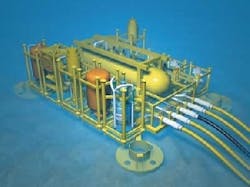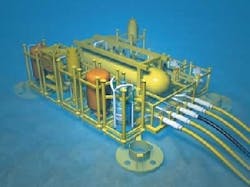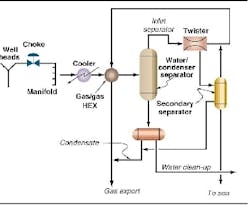PRODUCTION TECHNOLOGY: Subsea sales-grade gas conditioning aimed at elimination of tieback host
The Twister tool for supersonic gas separation, introduced in 2000, could be maturing into a possible "magic bullet" for flow assurance and subsea tieback difficulties. Twister dries gas without the use of moving parts or chemicals. This ability coupled with its compact footprint makes it an attractive solution for not normally manned platforms and possibly subsea developments.
The system uses a Laval nozzle to expand gas to supersonic velocities, which lowers the temperature and pressure. At these speeds, nucleation and condensation of water, as well as hydrocarbon droplets, takes place. When the flow strikes a specially designed delta wing, the droplets are knocked into a centrifugal swirl that throws them onto the walls of the unit, separating the liquids from the gas stream.
The gas continues to flow with as much as 70-80% of original pressure intact. Because it uses the natural energy of the gas stream to perform this separation, the system has no moving parts, and requires no fuel or chemicals.
Development advances
The Twister organization announced it has had two units running continually for the past year to monitor such things as erosion of the delta wing inside the unit. A recent report on test progress indicated that the units were performing up to expectation.
The original Twister field tests were conducted at the Leermans field test facilities in the Netherlands. This facility is available for producers that require dedicated field testing of a specific unit. A second Twister is operating at the Utorogu Gas Treatment facility in Nigeria. The unit has been operating at this facility since the fourth quarter of 2000.
The goal is to show that the system can operate in harsh conditions and also train the plant staff to operate and maintain the unit. Tests showed Twister could continue to operate during power outages, and during periods when glycol supplies were low (to the conventional JT/LTS units) since it requires neither power or chemicals to function properly. The developers hope to build a "plug and play" version of the unit that could be installed for field tests and evaluation in producer trains.
Subsea applications
The gas separation technology is being designed for use on two trains, each consisting of six Twister tubes, on one of Sarawak Shell Berhad's platforms, the B11 platform project. A partnership with FMC Kongsberg Subsea, could involve additional subsea gas separation units in the future. The contract with Sarawak Shell will involve installation of two trains to dehydrate gas headed to the MLNG-DUA plant, beginning in 2003.
Beyond moving the units offshore with the B11 project, Twister's developers were interested in providing flow assurance for subsea developments. Michael Lander, Marketing/Sales Manager for the Twister group, said the company's expertise is in gas processing, rather than subsea applications.
By partnering with FMC Kongsberg Subsea, Twister hopes to eventually apply its technology to subsea projects where cold temperatures and extended tiebacks make both hydrate formation and fluids slugging major flow assurance issues. The scope of the partnership is limited to a feasibility study with a goal of installing a subsea separation system within the next four years.
The first stage of the feasibility study involves identifying the basic components of the system that need to function subsea. This creates a simplified diagram of the major components that can be used by the partners. By designing the basic processing scheme, Twister will assist FMC Kongsberg in designing the proper subsea systems.
Modifications to the Twister will be minor, since it supports the template. It is the template that will involve overcoming major technology gaps. This design will be addressed by Kongsberg, Lander said, this is the main reason for the partnership. Overall, he expects that most of the engineering work in this phase of the partnership will be done by Twister and Kongsberg. Once the process flow scheme is designed, then the partners will convert this design into a product the market can use. To do this requires that technology gaps be first identified, then addressed.
Dense-phase gas
Once the key components of the subsea dehydration system are identified, then these components must be developed and tested. One specific technical area that will be tested early on is Twister's ability to process dense-phase gas.
To date, Twister testing has been done at the pressures commonly used in the industry, with the gas reservoir flow often choked down. However, if the unit were installed subsea, there would be an incentive to move the gas at as high a pressure as possible to optimize the natural energy in the well. This means handling dense-phase gas with a very high exit pressure.
Plans are to test the Twister at Statoil's K-Lab facility in Karsto, Norway. This lab is capable of providing the unit with input gas pressures in the range of 150 bar. This is less than the expected 200 bar the industry will most likely require, but it is high enough to determine how the unit performs with dense-phase input, Lander said. The tests should occur in the fourth quarter of this year or the first quarter of 2002.
Subsea to shore
All of this research and development will be done with an eye toward efficiency and price, since the Twister system has to compete with chemical-based flow assurance systems. Lander said that as part of the process, the company is looking at a number of existing subsea gas fields to determine the impact such a system might have had were it put in place when the fields were first brought online.
Among those being reviewed is Shell's Mensa, the longest subsea gas tieback in the world. If the Twister could be used in a system to dry the gas as it comes out of the hole, the question becomes how that would affect the cost of producing the field.
Lander said the Twister partnership is working closely with the operators to determine exactly how the subsea system can best address customer's needs. Looking further out, Lander said the goal would be a subsea Twister system that could condition gas to sales grade.
If sales-grade gas conditioning is possible, at high pressures, then a subsea field could be tied back directly to a sales line, eliminating the need for a host facility altogether. Of course, this would not be the case for all fields and is a very distant goal at best. Lander calls it a vision. "It's important to have a vision, don't you think?" he stated.
An artist rendition of how the Twister might be applied subsea.
A process scheme for a Twister unit shows the different components required to move the technology offshore and possibly subsea.
Dense-phase gas
Once the key components of the subsea dehydration system are identified, then these components must be developed and tested. One specific technical area that will be tested early on is Twister's ability to process dense-phase gas.
To date, Twister testing has been done at the pressures commonly used in the industry, with the gas reservoir flow often choked down. However, if the unit were installed subsea, there would be an incentive to move the gas at as high a pressure as possible to optimize the natural energy in the well. This means handling dense-phase gas with a very high exit pressure.
Plans are to test the Twister at Statoil's K-Lab facility in Karsto, Norway. This lab is capable of providing the unit with input gas pressures in the range of 150 bar. This is less than the expected 200 bar the industry will most likely require, but it is high enough to determine how the unit performs with dense-phase input, Lander said. The tests should occur in the fourth quarter of this year or the first quarter of 2002.
Subsea to shore
All of this research and development will be done with an eye toward efficiency and price, since the Twister system has to compete with chemical-based flow assurance systems. Lander said that as part of the process, the company is looking at a number of existing subsea gas fields to determine the impact such a system might have had were it put in place when the fields were first brought online.
Among those being reviewed is Shell's Mensa, the longest subsea gas tieback in the world. If the Twister could be used in a system to dry the gas as it comes out of the hole, the question becomes how that would affect the cost of producing the field.
Lander said the Twister partnership is working closely with the operators to determine exactly how the subsea system can best address customer's needs. Looking further out, Lander said the goal would be a subsea Twister system that could condition gas to sales grade.
If sales-grade gas conditioning is possible, at high pressures, then a subsea field could be tied back directly to a sales line, eliminating the need for a host facility altogether. Of course, this would not be the case for all fields and is a very distant goal at best. Lander calls it a vision. "It's important to have a vision, don't you think?" he stated.


